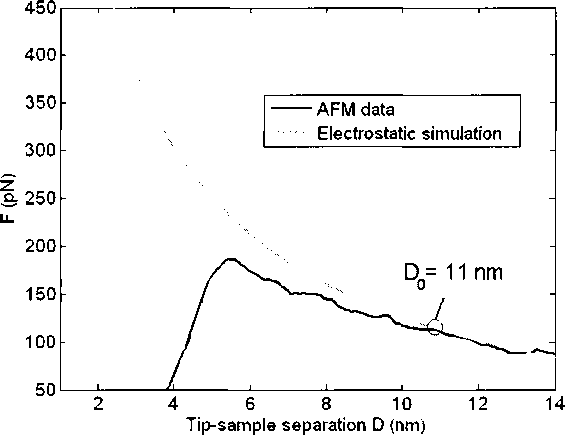AFM TIP
D = 11 nm
AFM TIP
LIPID BILAYER
LlPlD BILAYER
Surface electrostatics
relatively unaffected by
AFM tip
AFM tip is close
enough to perturb the
surface
Figure 3.4: (Left) The finite element model is solved with a constant charge density
boundary condition from D = 40 nm to D = 11 nm as in Chapter 2. Note that these values
of D are for the data shown in Figure 3.2. For other data sets, the D values will be
different. For D = 11 nm and less, we vary the lipids surface charge density according to
the law governing the phenomenon being addressed (i.e. whether it is counterion binding
or mobile lipid charge regulation).

Figure 3.5: Do is chosen as the point where the AFM data starts deviating significantly
from the electrostatic simulation of Chapter 2. For the above sample, Dq = 11 nm. The
AFM data and the electrostatic simulation shown here is the same as in Figure 3.2.
32
More intriguing information
1. The name is absent2. Evidence on the Determinants of Foreign Direct Investment: The Case of Three European Regions
3. SOME ISSUES CONCERNING SPECIFICATION AND INTERPRETATION OF OUTDOOR RECREATION DEMAND MODELS
4. Economies of Size for Conventional Tillage and No-till Wheat Production
5. The Structure Performance Hypothesis and The Efficient Structure Performance Hypothesis-Revisited: The Case of Agribusiness Commodity and Food Products Truck Carriers in the South
6. The Cost of Food Safety Technologies in the Meat and Poultry Industries.
7. Passing the burden: corporate tax incidence in open economies
8. Developmental changes in the theta response system: a single sweep analysis
9. Feeling Good about Giving: The Benefits (and Costs) of Self-Interested Charitable Behavior
10. The Variable-Rate Decision for Multiple Inputs with Multiple Management Zones